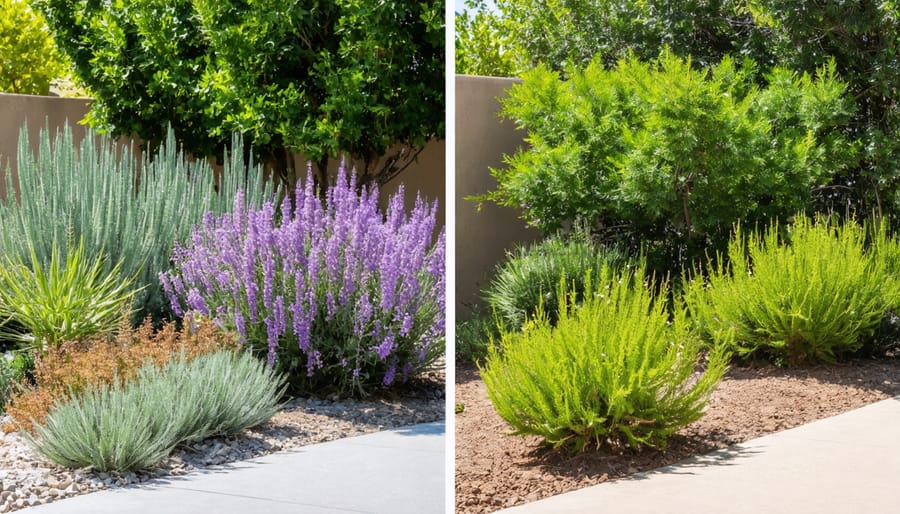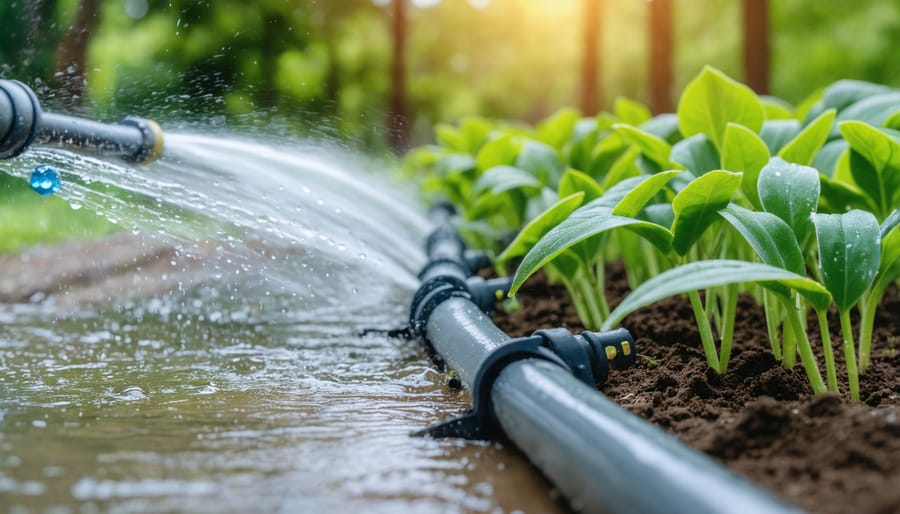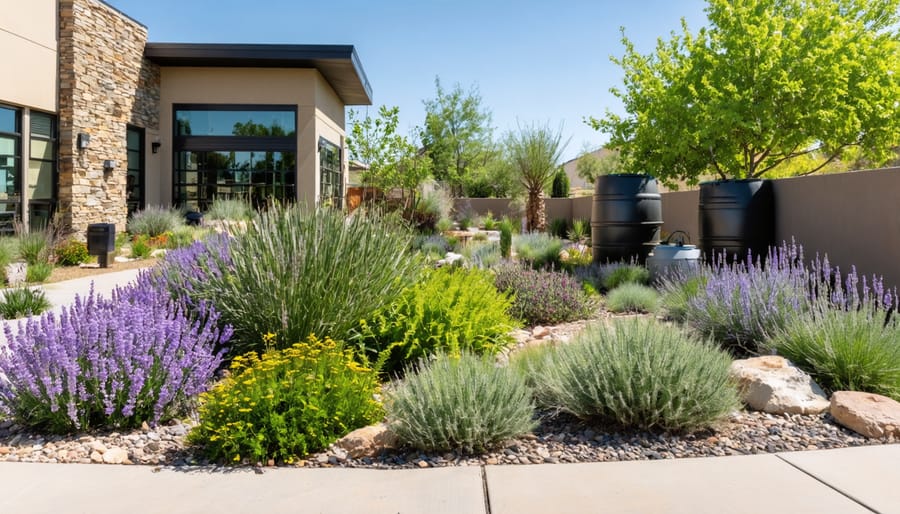Transform your landscape into a water-efficient oasis by grouping plants with similar water needs, installing smart irrigation controllers, and replacing thirsty lawns with drought-resistant groundcovers. Creating smart outdoor living solutions through water-wise landscaping cuts water bills by 50-70% while maintaining a vibrant, low-maintenance yard. Layer native plants to naturally shade soil, reduce evaporation, and create wildlife habitats. Add a 2-3 inch layer of organic mulch around plants, install rain barrels to capture natural precipitation, and incorporate permeable hardscaping that allows water to seep into the ground rather than run off. Modern drip irrigation systems deliver water directly to plant roots, eliminating the waste of traditional sprinklers while nurturing deeper, healthier root systems that require less frequent watering.
Smart Plant Selection for Maximum Impact
Native Plants That Thrive With Less Water
When planning your eco-friendly garden design, choosing native plants adapted to your local climate is key to successful water-wise landscaping. These resilient plants have evolved to thrive in your region’s natural conditions, requiring minimal supplemental watering once established.
For Mediterranean climates, consider drought-resistant options like lavender, sage, and rosemary, which add both beauty and fragrance to your landscape. These herbs not only conserve water but also attract beneficial pollinators to your garden.
In arid regions, native succulents and cacti create striking visual interest while demanding very little maintenance. Agave, yucca, and various sedums store water naturally in their leaves, making them perfect choices for water-conscious gardeners.
For temperate zones, consider incorporating native wildflowers like black-eyed susans, coneflowers, and butterfly weed. These hardy perennials develop deep root systems that help them survive dry spells while providing colorful blooms throughout the growing season.
Ornamental grasses like blue fescue and little bluestem offer year-round interest and require minimal watering. They’re particularly effective when grouped together in decorative clusters or used as natural borders.
Remember to group plants with similar water needs together to maximize irrigation efficiency. This practice, known as hydrozoning, ensures that each plant receives just the right amount of water without waste.

Strategic Plant Grouping
Strategic plant grouping, often called hydrozoning, is a game-changer for water-wise landscaping. By placing plants with similar water needs together, you’ll create efficient watering zones that prevent both over- and under-watering. Think of it as creating “water neighborhoods” in your garden.
Start by dividing your landscape into three main zones: high, moderate, and low water-use areas. High-water zones might include lush flowering plants and vegetables that need regular watering. Place these closer to your home where you can easily monitor them. Moderate-water zones work well for many ornamental shrubs and perennials that can tolerate occasional dry spells. Reserve low-water zones for drought-resistant natives and succulents that thrive with minimal irrigation.
Sun exposure plays a crucial role in plant grouping too. Consider creating separate zones for full sun, partial shade, and full shade areas. Plants in full sun typically need more water than those in shaded spots, so factor this into your watering schedule.
Here’s a practical tip: place thirsty plants at the bottom of slopes where water naturally collects, and position drought-tolerant varieties on higher ground or slopes. This natural approach to water distribution helps reduce your overall irrigation needs while keeping your landscape looking beautiful and healthy.
Remember to group plants with similar growth rates and maintenance needs together. This thoughtful organization makes garden care more efficient and helps ensure every plant gets exactly what it needs to thrive.
Efficient Irrigation Solutions
Drip Irrigation Systems
Drip irrigation systems represent one of the most efficient ways to water your landscape, delivering water directly to plant roots while minimizing waste. These systems use a network of tubes and emitters to provide slow, steady moisture exactly where it’s needed, reducing water consumption by up to 70% compared to traditional sprinklers.
The beauty of drip irrigation lies in its versatility and precision. Small emitters release water at rates as low as one gallon per hour, allowing deep soil penetration without runoff or evaporation. Plants thrive with this consistent moisture delivery, developing stronger root systems and showing improved growth patterns.
Installing a drip system is surprisingly straightforward. Start by connecting the main line to your water source through a pressure regulator and filter. Then, run smaller distribution tubing to your planting areas, adding emitters near each plant’s root zone. For new gardens, install the system before planting to ensure optimal placement.
Key benefits include:
– Reduced water bills and conservation
– Fewer weeds due to targeted watering
– Prevention of leaf diseases by keeping foliage dry
– Flexibility to adjust water flow for different plant needs
– Easy automation with timers
Maintenance is minimal but important. Regular checks for clogged emitters and periodic system flushing keep everything running smoothly. Consider installing a smart controller that adjusts watering based on weather conditions for even greater efficiency.
For vegetable gardens and flower beds, use closely spaced emitters or drip tape for uniform coverage. Around trees and larger shrubs, place multiple emitters in a circle to encourage proper root development. This targeted approach ensures every drop counts in your water-wise landscape.

Smart Controllers and Sensors
Modern technology has revolutionized the way we manage water in our landscapes, making conservation easier and more efficient than ever. Smart controllers and sensors work together to create an intelligent irrigation system that responds to real-time conditions, eliminating wasteful watering practices.
Weather-based controllers, also known as ET (evapotranspiration) controllers, automatically adjust watering schedules based on local weather data. These devices connect to WiFi to receive weather updates and modify irrigation timing accordingly. When rain is forecasted, the system automatically skips scheduled watering, preventing unnecessary water usage and potential plant damage.
Soil moisture sensors are another game-changing technology that takes the guesswork out of watering. Placed strategically throughout your landscape, these sensors measure the actual moisture content in your soil and communicate with your irrigation controller. This ensures plants receive water only when they truly need it, promoting deeper root growth and healthier vegetation.
Flow sensors add an extra layer of protection by monitoring water usage and detecting leaks. If unusual flow patterns are detected, these smart devices can automatically shut off the system and alert you through a mobile app, preventing water waste and potential landscape damage.
Rain sensors, while simple in concept, are highly effective at preventing irrigation during or immediately after rainfall. These affordable devices can be easily retrofitted to existing systems and provide immediate water savings.
For ultimate convenience, many of these smart devices can be controlled through smartphone apps, allowing you to monitor and adjust your irrigation system from anywhere. Some systems even provide detailed water usage reports and recommendations for optimizing your watering schedule based on seasonal changes and plant needs.
Water-Retaining Landscape Features
Mulching Techniques
Proper mulching is a cornerstone of water-wise landscaping, acting as a protective blanket that retains moisture and suppresses weed growth. The key to successful mulching lies in choosing the right materials and applying them correctly. Organic mulches, such as bark chips, straw, or leaves, gradually break down to enrich your soil while conserving water. For a more permanent solution, inorganic options like gravel or river rocks offer excellent water retention and add aesthetic appeal to your landscape.
When applying mulch, maintain a depth of 2-4 inches around your plants, being careful not to pile it against stems or tree trunks. This spacing prevents rot and allows proper air circulation. For vegetable gardens and annual beds, lighter mulches like straw or grass clippings work best, while woody areas benefit from heavier materials like bark or wood chips.
Consider laying landscape fabric beneath your mulch in areas with persistent weed problems. This extra barrier provides superior weed control while still allowing water to penetrate. Remember to refresh organic mulch annually as it decomposes, and rake occasionally to prevent matting.
For slopes and hillsides, use shredded mulch or tackified options that won’t wash away easily during rain. In wind-prone areas, opt for heavier materials or consider adding decorative rocks to hold lighter mulch in place. This thoughtful approach to mulching not only conserves water but also creates a polished, low-maintenance landscape.
Rain Gardens and Bioswales
Rain gardens and bioswales are beautiful, functional additions to any water-wise landscape that naturally manage stormwater while creating stunning garden features. These innovative water features for conservation work by collecting rainwater runoff from roofs, driveways, and other hard surfaces, allowing it to slowly filter through layers of soil and plants before returning to the groundwater system.
To create a rain garden, choose a natural depression in your yard or dig a shallow basin, typically 4-8 inches deep. Plant it with native species that thrive in both wet and dry conditions, such as butterfly weed, black-eyed susans, and switchgrass. These plants develop deep root systems that help filter pollutants and prevent soil erosion.
Bioswales are similar but typically longer and narrower, perfect for directing water flow along property boundaries or driveways. They’re particularly effective at reducing flooding and preventing water pollution. When designing your bioswale, create a gentle slope and layer it with gravel, sand, and rich soil to maximize filtration.
Both features require minimal maintenance once established and can reduce your irrigation needs significantly. They also attract beneficial wildlife like butterflies and birds, adding natural beauty to your landscape while serving an essential environmental purpose. Consider incorporating these elements near downspouts or in areas where water naturally collects for maximum effectiveness.

Storage Solutions for Water Conservation
Rain Barrel Systems
Rain barrel systems offer an eco-friendly solution for collecting and storing rainwater, reducing your reliance on municipal water supplies for landscape irrigation. By capturing water from your roof’s downspouts, these systems can collect hundreds of gallons during a single rainfall event, providing free water for your garden throughout drier periods.
Installing a rain barrel is straightforward and cost-effective. Position your barrel beneath a downspout, ensuring it sits on a level, stable surface. For best results, elevate the barrel on a sturdy platform to create better water pressure for irrigation. Most systems include an overflow valve, screening to keep out debris and insects, and a spigot for connecting a garden hose.
To maximize your collection system’s efficiency, consider linking multiple barrels together. This setup, known as daisy-chaining, allows excess water to flow from one barrel to the next, increasing your storage capacity. During winter months in colder climates, empty and clean your barrels to prevent freeze damage.
Maintenance is minimal – regularly clean screens, check connections for leaks, and ensure overflow valves are clear. Remember to use collected water within a reasonable timeframe to prevent mosquito breeding and maintain water quality.
Tool and Equipment Storage
Proper storage of your irrigation equipment and landscaping tools is crucial for maintaining an efficient water-wise garden. A well-organized storage solution not only protects your investment but also makes maintenance tasks more manageable. Consider installing a weather-resistant shed or storage cabinet to house your irrigation controllers, spare parts, and seasonal equipment.
To effectively organize your gardening tools, create designated zones for different categories: irrigation supplies, hand tools, power equipment, and maintenance materials. Use wall-mounted pegboards or tool racks to keep items visible and easily accessible. Store delicate equipment like smart irrigation controllers and sensors in waterproof containers to protect them from moisture damage.
Keep frequently used items at eye level and establish a maintenance corner where you can perform quick repairs or adjustments to your irrigation system. Label storage containers and create an inventory list to track supplies and replacement parts. This organized approach ensures you can quickly respond to any irrigation issues and maintain your water-wise landscape efficiently throughout the seasons.
Creating a water-wise landscape is not just an environmentally conscious choice; it’s a smart investment in your home’s future. By implementing the strategies we’ve discussed, from choosing drought-resistant plants to installing efficient irrigation systems, you can reduce your water consumption while maintaining a beautiful outdoor space that enhances your property’s value.
Remember that transitioning to a water-wise landscape doesn’t have to happen all at once. Start with simple steps like adjusting your watering schedule and gradually replace water-hungry plants with drought-tolerant alternatives. Consider investing in a rain barrel or updating your irrigation system to make the most of every drop.
The benefits of water-wise landscaping extend beyond conservation. You’ll spend less time on maintenance, save money on water bills, and create a resilient garden that thrives in various weather conditions. Plus, many native and drought-resistant plants attract beneficial wildlife, adding natural beauty and ecological value to your yard.
Take some time to assess your current landscape and identify areas where you can make water-wise improvements. Whether you’re starting from scratch or renovating an existing garden, the principles of water-wise landscaping can help you create an outdoor space that’s both beautiful and sustainable for years to come.
Your efforts in water conservation today will contribute to a greener future while providing you with a stunning, low-maintenance landscape to enjoy.





Leave a Reply